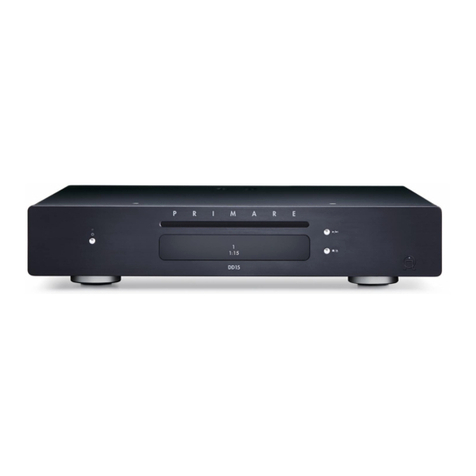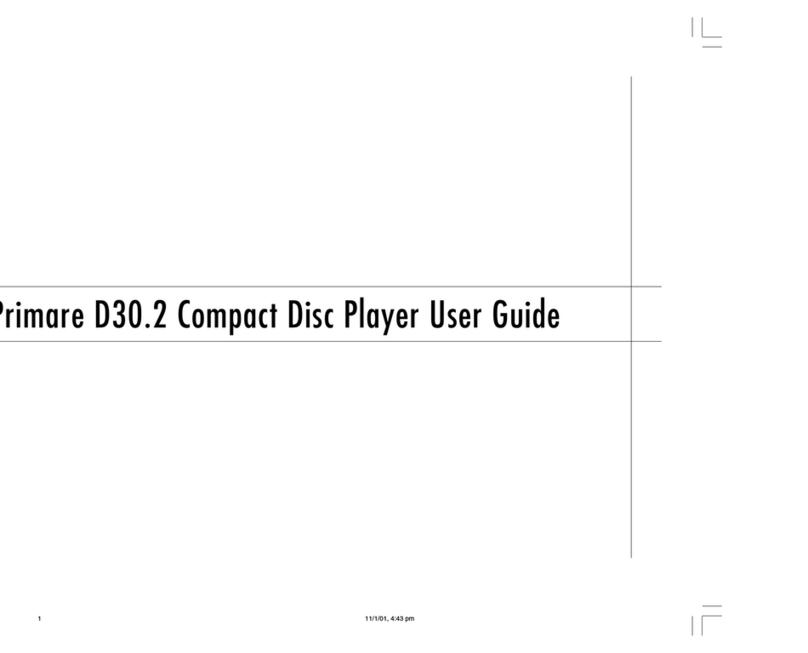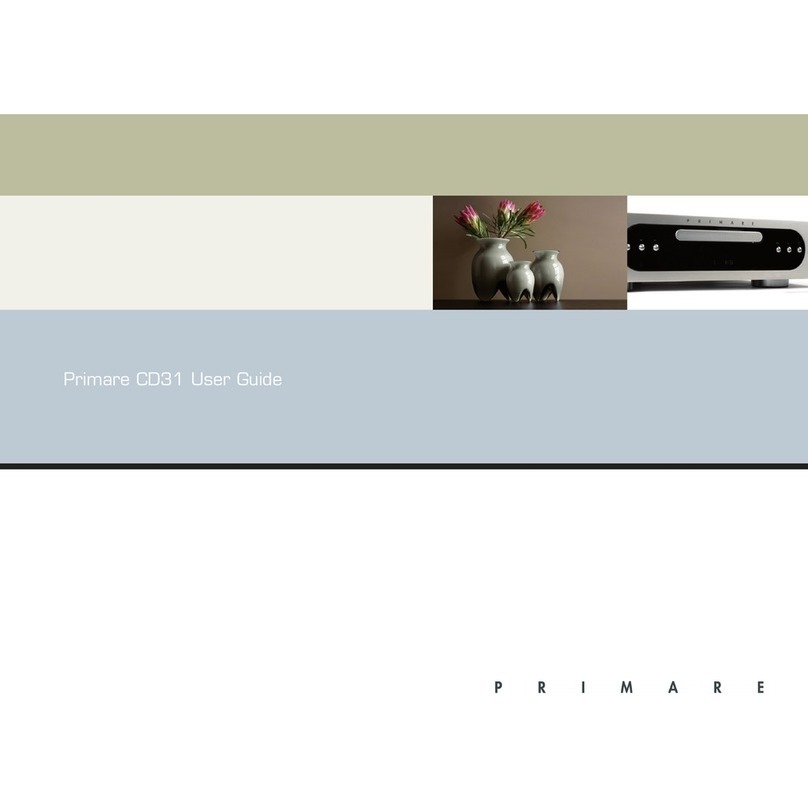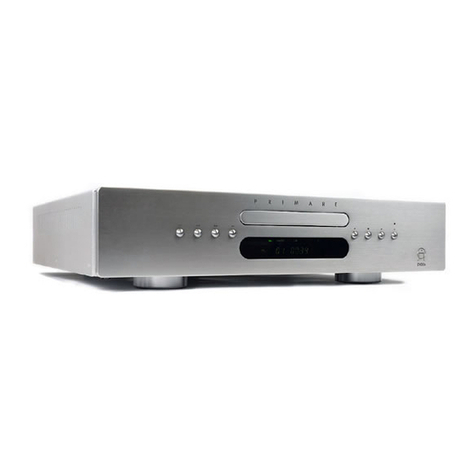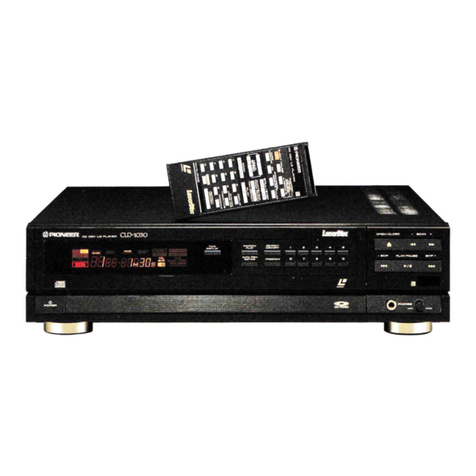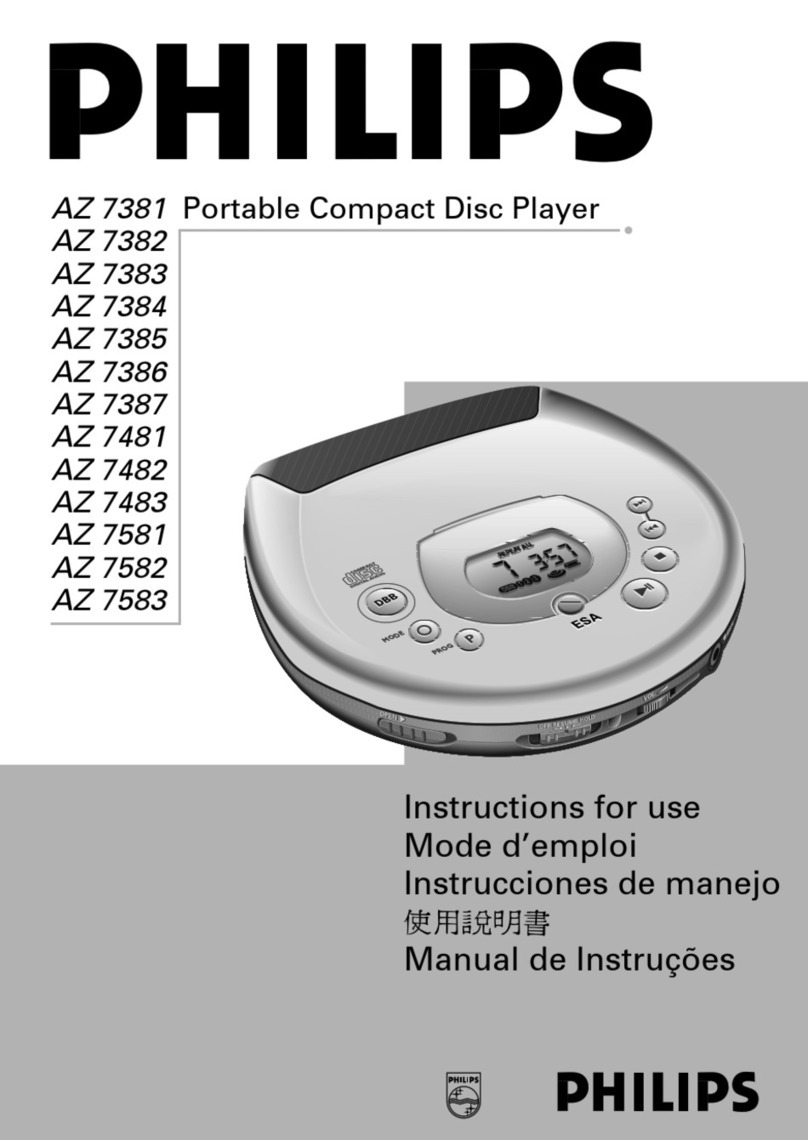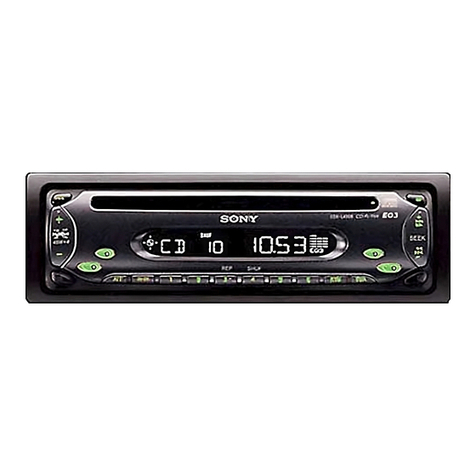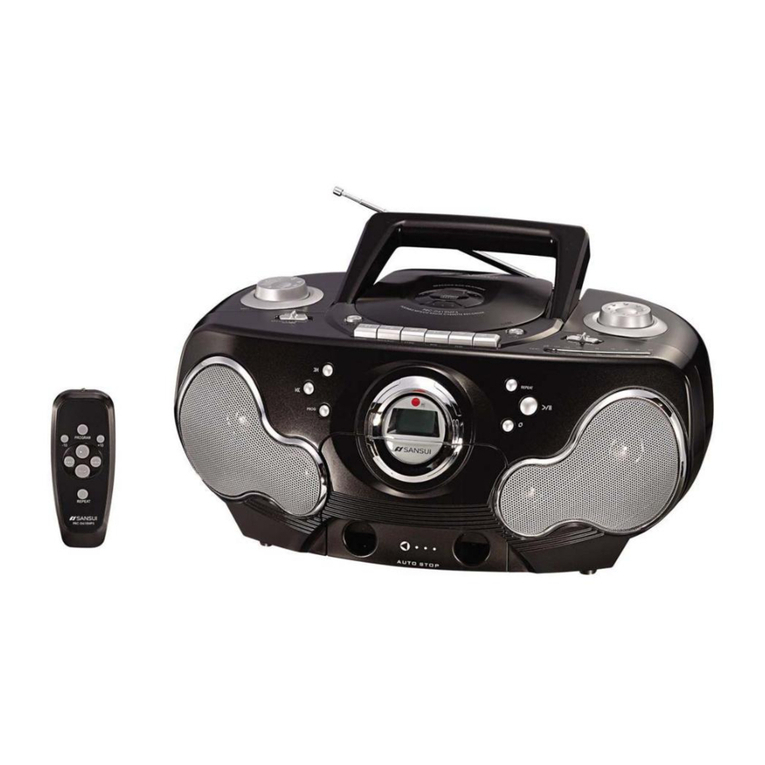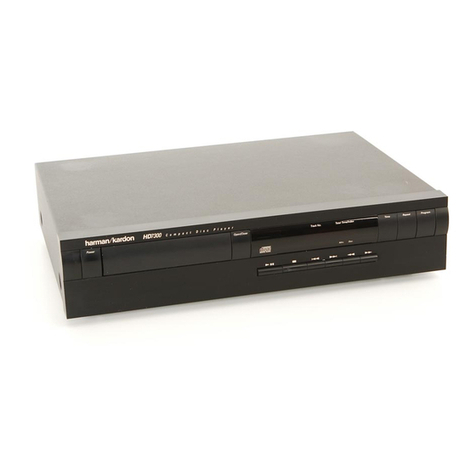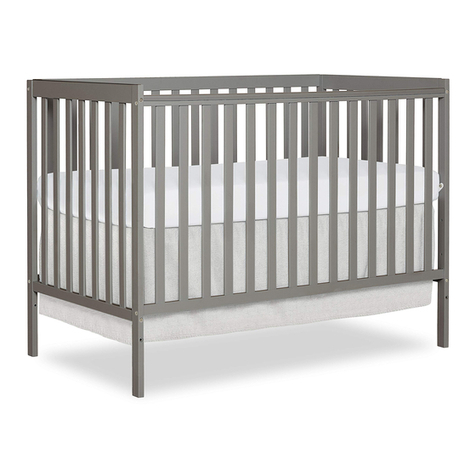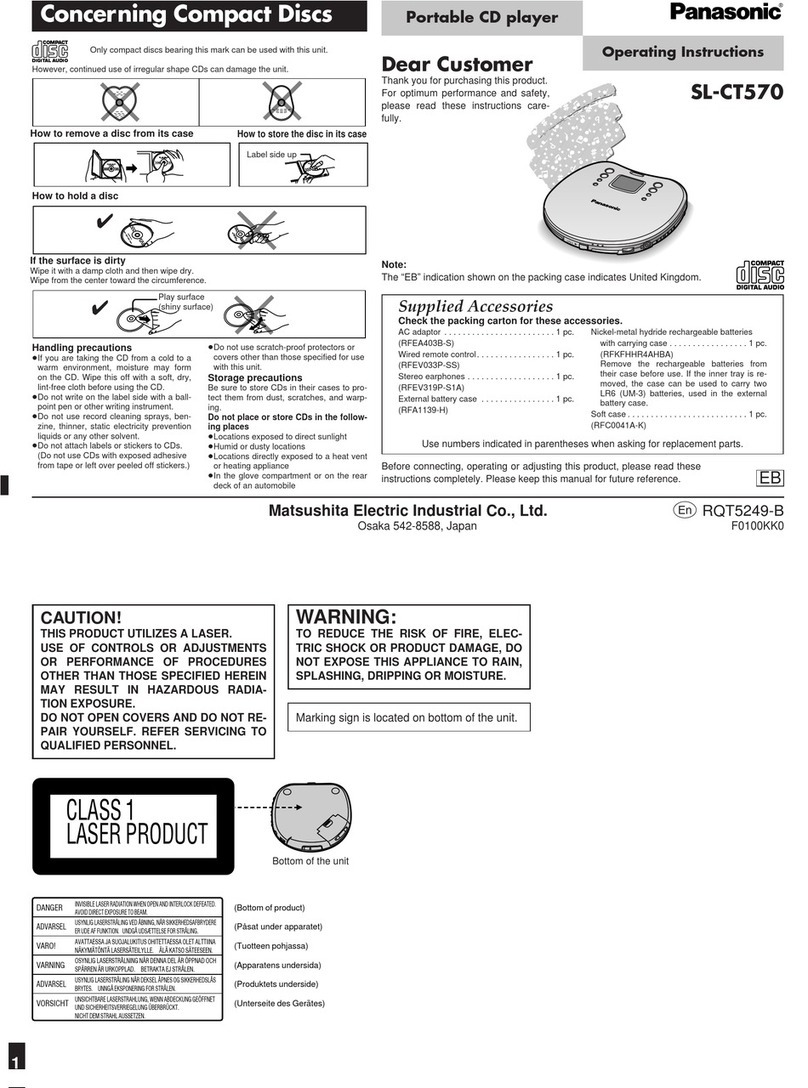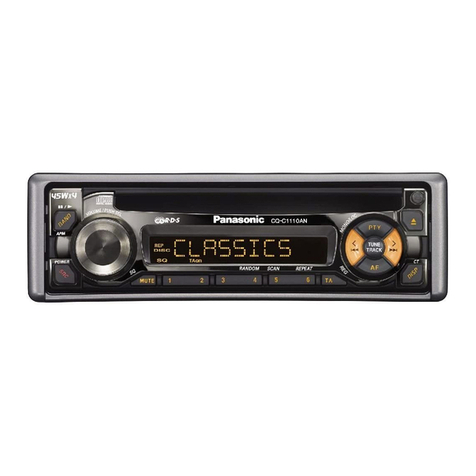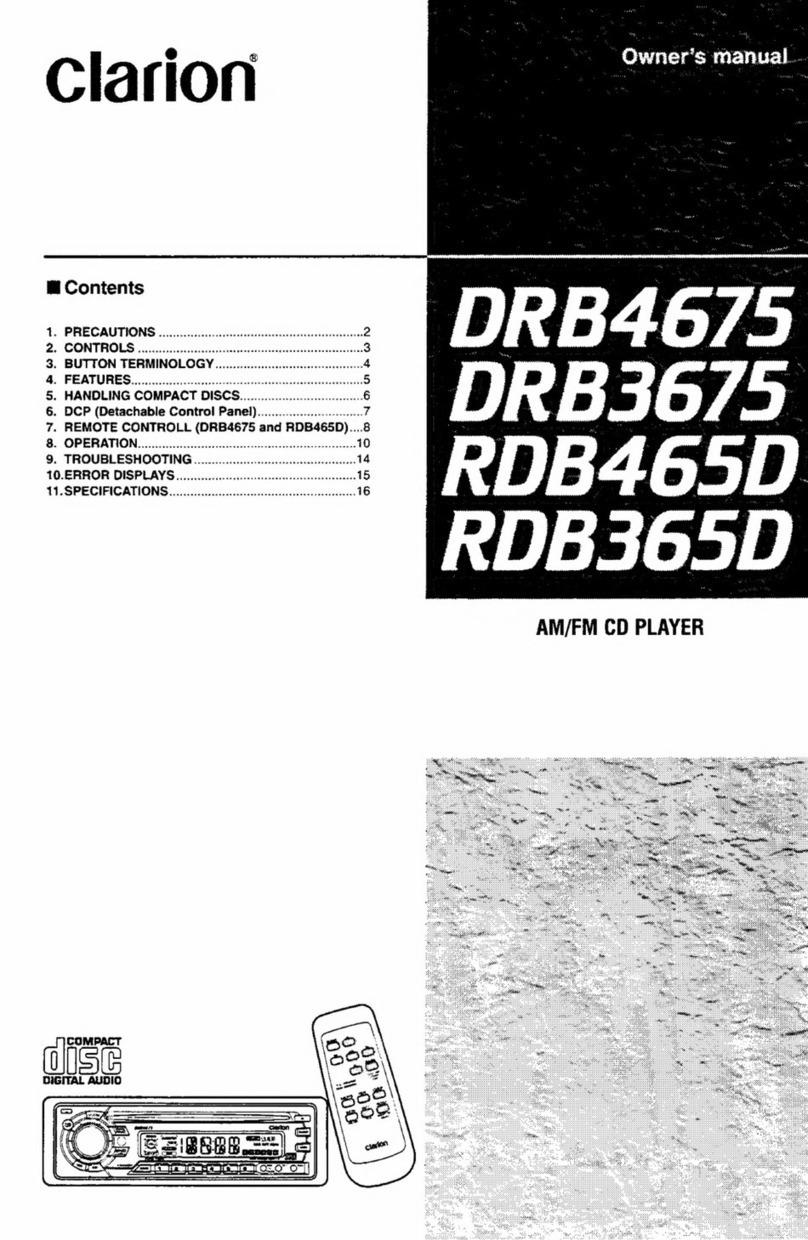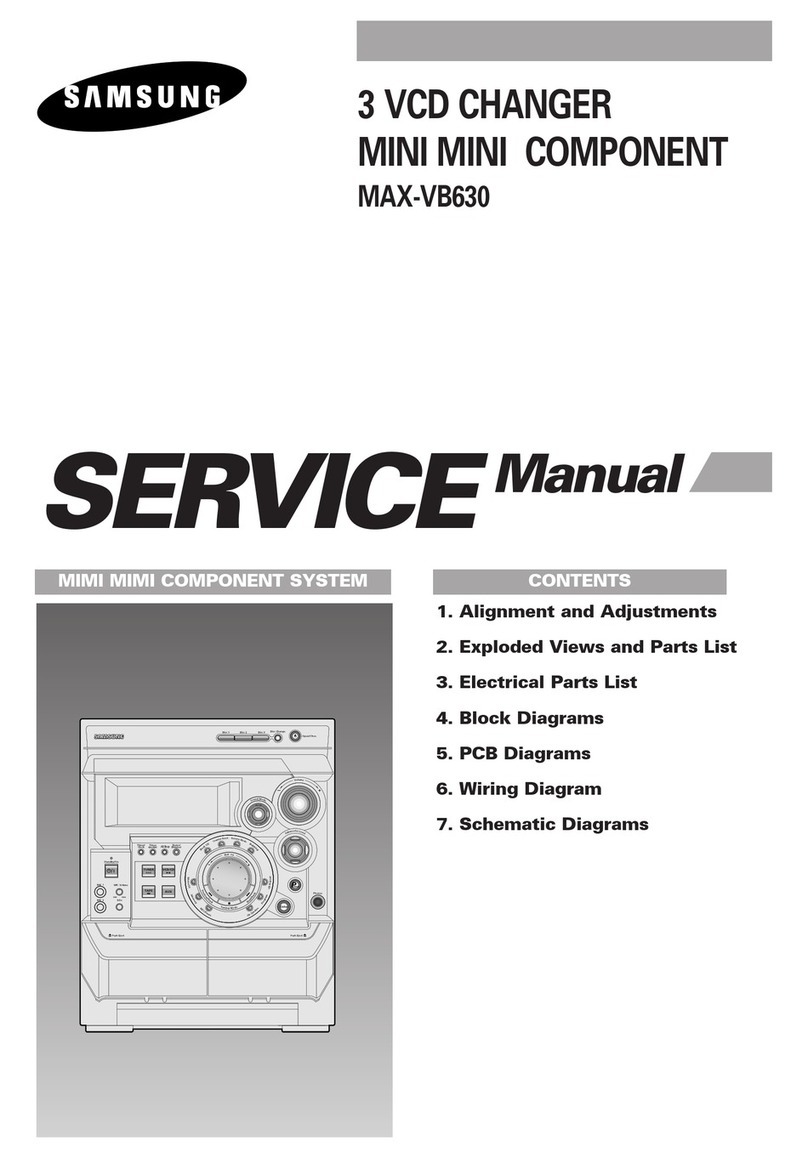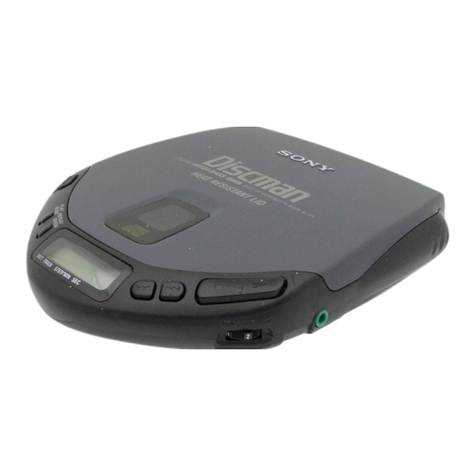Primare CD32 User manual


XLR (R) RCA XLR (L) SPDIF TOSlink AES/EBU Trigger in/out RS-232 Not active Power
On/off
USB input IR in/out
Analogue outputs Digital outputs
Welcome to the Primare CD32! Your CD32 is a high-quality compact disc player
with analogue and digital outputs.

Your CD32 is supplied with the following
components:
•Mains cable.
•C23 remote control.
•Two batteries for the remote control.
If any of these items are missing please contact
your supplier. We recommend you retain the
packaging in case you need to transport the unit
at a later date.
Analogue outputs
The analogue output provides for both the
recommended balanced XLR outputs and the
conventional unbalanced RCA for connection with
an appropriate stereo amplifier or preamplifier.
•Connect the appropriate outputs to your
amplifier or preamplifier using a suitable cable.
Digital outputs
Alternatively the CD32 Compact Disc Player
provides one SPDIF, oneTOSlink, and one
AES/EBU digital output for connection to a digital
preamplifier or digital surround processor.
•Connect the appropriate output to your
preamplifier or surround processor using a
suitable cable.
•Plug one end of the mains cable supplied with
the CD32 into the power connector on the
back panel, and connect the other end to a
wall socket.
If this cable is not suitable for your power outlets
please contact your supplier for an alternative
cable.
Note: See
Phase
, page 8, for information about
getting the best sound from your CD32.
WARNING: Always disconnect the
CD32 from the mains power before
connecting or disconnecting any cables.
•Switch on the CD32, using the switch on the
back panel.
The standby indicator will light up on the front
panel.
To switch on from standby
•Press the Obutton on the front panel or
remote control.
The display shows:
PRIMARE
Press the Obutton again to switch to standby.
•Press the */åbutton on the front panel or
remote control to open the tray.
•Place the CD in the tray with the label facing
upwards.
•Press the >button on the front panel, or the
>/=button on the remote control, to close
the tray and start playing the disc.
For more information about playing a CD see the
next page.
For more information about playing music files
from a USB disk see
Playing music files from a
USB disk
, page 7.
Set up your CD32 in four simple steps:

Standby O
Switches the CD32 to standby, or switches it on
from standby.
Stop/Open */å
When the disc is playing: pauses the disc.
When the disc is paused: stops the disc.
When the disc is stopped: opens or closes the
CD tray.
Press and hold: opens the CD tray.
Play/Skip >/]
When the disc is stopped: plays the disc.
When the disc is playing: skips to the next track.
Press and hold: skips back through the tracks.
To insert a disc
•Press the */åbutton on the front panel, or
on the remote control, to open the tray.
•Place the CD in the tray with the label facing
upwards.
•Press the */åbutton again to close the tray
(or press the >button).
The display shows:
READING
followed by the number of tracks and total time:
19
74:59
To play the disc
•Press the >button on the front panel, or the
>/=button on the remote control.
While a disc is playing the display shows the
current track number and the elapsed time of the
current track; for example:
7
1:24
To pause the disc
•Press the */åbutton on the front panel or
the remote control while the disc is playing.
The display shows the pause symbol:
=
You can then resume play by pressing the >/]
button on the front panel or the >/=button on
the remote control.
To stop play
•Press the */åbutton on the front panel or
the remote control.
You can skip between tracks to locate a particular
track on the disc, or you can scan forwards or
backwards to locate a position within a track.
To skip forwards through the tracks
•Press the >/]button on the front panel, or
press the ]button on the remote control.
To skip back through the tracks
•Press and hold the >/]button on the front
panel, or press the [button on the remote
control.
The front panel display shows the track number:
12
•Release the button to start playing the
selected track from the beginning.
To scan through the disc
•Press the ¯or ˘button on the remote
control once to scan at 4X speed, or twice to
scan at 8X speed.
The display shows the position within the track.
•Press the >button on the front panel, or the
>/=button on the remote control to start
playing from the position you have located.
This page explains how to operate your CD32, using the functions available from
either the front panel or the C32 remote control.

Before using the remote control you need to
insert the two AAA batteries supplied with the
C23.
•Gently slide open the cover on the back of
the remote control:
•Insert the two batteries, observing the
polarity printed on the bottom of battery
compartment:
•Slide back the cover until it clips into place:
Note: Replace only with alkaline
batteries type AAA, LR03, or
equivalent.
When disposing of old batteries please be
considerate to the environment.
Enter track number
Switch on/off
Play or pause the disc
Enter number >10
Increase volume of amplifier
Restart the current track,
or skip to the previous track
Repeat the track or disc
Change the displayed information
Skip to the next track
Change the
display brightness
Select between disc and USB
Shuffle tracks
Reverse scan
Forward scan
Open or close the CD tray,
or stop the disc
Change the sampling rate
Programme a sequence of tracks
Decrease volume of amplifier
Select CD mode
Display tracks in a folder
on USB menu
Move up on USB menu
Move down on USB menu
Select item on USB menu
Display folders on USB menu
This page explains how to
use the C23 remote control
to operate the CD32, and
how to fit the batteries into
the remote control.

This chapter explains how to use the more advanced features of the CD32, and
how to play audio files from a USB disk. These functions are accessed from the
remote control.
You can choose how the time is shown on the
front panel display, and change the brightness.
To change the time display
•Press the DISP button..
The display switches between the following four
options:
Elapsed time for the current track
3:45
Remaining time for the current track
1:15 RT
Elapsed time for the entire disc
ALL 18:45
Remaining time for the entire disc
ALL 41:15 RT
To change the front panel display brightness
•Press the DIM button to step through the
three levels of illumination and blank.
The display auto-dims after a few seconds and
returns to the selected brightness when you
operate any control.
You can play the current track repeatedly, or
repeat the entire disc.
To repeat the current track
While the disc is playing:
•Press the REPEAT button.
The front panel shows the symbol and TRK.
To repeat the entire disc
•Press the REPEAT button twice.
The front panel shows the symbol and ALL.
To turn off repeat
•Press the REPEAT button again.
The symbol in the display will be cleared.
Shuffle playback plays the tracks on the disk in
random order.
To play the tracks in random order
While the disc is playing:
•Press the blue Bbutton.
The front panel shows the symbol:
In shuffle mode you can pause a track by pressing
the >/=button or skip a track by pressing the ]
button.
To turn off shuffle
•Press the blue Bbutton again.
The symbol in the display will be cleared.
You can play from any track by entering the track
number on the remote control.
To play from a specific track
•Specify the track number by pressing one of
the buttons 1-9.
To enter a two-digit track number press the +10
button first. For example, to enter 16 press the
+10 button followed by the 1and 6buttons.
The CD32 allows you to upsample the 44.1kHz
signal from a CD to either 48kHz or 96kHz, which
improves fine detail, sound stage depth and image
separation.
•Press the red Rbutton to select between
44.1K, 48K, and 96K (recommended).

The CD32 Compact Disc Player allows you to
programme a sequence of tracks on the current
disc.You can then play just the tracks you have
programmed.
To programme a sequence of tracks
While the disc is stopped:
•Press the green Gbutton.
The front panel display shows:
P
•Use the 1-9and +10 buttons to enter the
numbers of the tracks you want to play.
As you enter each track number the front panel
display shows the current track, preceded by the
tracks you have already programmed in small text:
02 04 06 08
P
To play the selection you have programmed
•Press the >/=button.
As the tracks play the display shows the sequence
of track numbers you have programmed, with the
currently playing track highlighted:
02 40 06 08 10 12 14
P
To step through the programmed tracks
While the tracks are playing:
•Press the [or ]button.
To clear the programme
•Press the */åbutton.
You can play MP3/WMA files on a USB disk or
memory stick by connecting it to the USB port.
To select the USB disk
•Press the AUDIO button.
The display shows:
USB
It will then show an alphabetical list of the folders
containing MP3 files on the USB disk.
Names that are too long to fit on the display will
scroll across.
To select a folder
•Press the Aor Vbutton to step between the
folders.
The display shows the current folder highlighted.
For example:
[Animal ]
[Echo ]
[Flesh Tone ]
[Rated R ]
[She Wolf ]
•Press the >or SELECT button to display
the tracks in the highlighted folder.
•Press the <button to return to the list of folders.
To select a track
•Press the Aor Vbutton to step between tracks.
The display shows the current track highlighted:
04 Home.mp3
05 Acapella.mp3
06 Scream.mp3
07 Emancipate.mp3
08 Brave.mp3
•Press the >/=, >, or SELECT button to play
from the highlighted track.
As each track plays the display shows the artist
and track name (or filename if this information is
not available), elapsed time, and track duration (or
VBR for Variable Bit Rate tracks).
To step through the tracks
While the tracks are playing:
•Press the [or ]button to step between
the tracks in the current folder.
To scan through a track
•Press the ¯or ˘button.
•Press the >/=button to start playing from
the position you have located.
Repeat and shuffle
•Press the REPEAT button to repeat the
Track (T), Folder (F) , or All (A).
•Press the blue Bbutton to shuffle the tracks
within a folder.

Every component of the CD32, from the CD transport to the audio output stage,
has been designed to achieve the highest possible audio performance.
Voltage: 2.1 VRMS
Impedance: 390Ω
Voltage: 4.1 VRMS
Impedance: 47Ω
Coaxial: SPDIF
Optical:TOSlink
AES/EBU: XLR
PCM Sample Rate: 44.1kHz
Upsampling: 44.1kHz, 48kHz, or 96kHz.
File format: MP3 or WMA
Disk format: FAT16 or FAT32
Mechanism: Asatech 8210.B01-02, Sanyo SF-
P101N
D/A Converter: 2x PCM1704, DF1706 (digital
filter), 24/96kHz
Frequency Response: 20Hz – 20kHz (-0.5dB)
Signal to Noise Ratio: 20Hz – 20kHz unweighted
-100 dB
THD + N: 20Hz – 20kHz <0.01%
Power Consumption: Operating 25W, Idle 22W,
Standby 0.5W
Dimensions: 430 x 385 x 110 mm
Weight: 9 kg
Color Options: Black,Titanium
These instructions help you get the best possible sound from your CD32, and give
information about configuring its advanced settings.
The phase of the AC supply can make a significant
difference to the sound.
Ensure that the live pin of the AC power cable
is connected to the left-hand pin of the power
connector, viewed from the back panel.
Your Primare will start to sound best after an
initial burn-in of approximately 24 hours.
You will notice a further smaller improvement in
sound quality for at least another 3 days’ playing.
The RS232 input allows you to connect the CD32
to a controller system. For more information
please contact Primare or visit www.primare.net.
The Trigger input allows the CD32 to be switched
on by another device, such as an I32.
The Trigger output allows the CD32 to switch on
other devices.
•Press the Obutton to switch on the CD32.
•Press and keep holding down the Obutton.
NOTE:You need to keep the Obutton held
down throughout this procedure.
•When the version number is displayed press
the */åbutton.
The display shows:
TRIG
•Press the >/]button to select between
TRIG ON, to enable the trigger input, or
TRIG OFF, to disable it.
•Press the */åbutton again.
The display shows:
IR
•Press the >/]button to select between
IR FRONT, to control the CD32 using a
remote control pointed at the front panel, or
IR BACK, to control it via the IR-input on the
back panel.
•Release the Obutton to return to normal
operation.

CAUTION: To reduce the risk of electrical shock
do not remove cover (or back). No user serviceable
parts inside. Refer servicing to qualified service
personnel.
WARNING: To reduce the risk of fire or electrical
shock, do not expose this apparatus to rain or
moisture.
CAUTION: In Canada and the USA, to prevent
electric shock, match the wide blade of the plug to
the wide slot in the socket and insert the plug fully
into the socket.
This product is designed and manufactured to meet
strict quality and safety standards. However, you
should be aware of the following installation and
operation precautions.
1.Take heed of warnings & instructions
You should read all the safety and operating
instructions before operating this appliance. Retain
this handbook for future reference and adhere to all
warnings in the handbook or on the appliance.
2.Water and moisture
The presence of electricity near water can be
dangerous. Do not use the appliance near water – for
example next to a bathtub, washbowl, kitchen sink, in
a wet basement or near a swimming pool, etc.
3. Object or liquid entry
Take care that objects do not fall and liquids are
not spilled into the enclosure through any openings.
Liquid-filled objects such as vases should not be
placed on the equipment.
4.Ventilation
Do not place the equipment on a bed, sofa, rug
or similar soft surface, or in an enclosed bookcase
or cabinet, since ventilation may be impeded.We
recommend a minimum distance of 50mm around
the sides and top of the appliance to provide
adequate ventilation.
5. Heat
Locate the appliance away from naked flames or
heat producing equipment such as radiators, stoves
or other appliances (including other amplifiers) that
produce heat.
6. Climate
The appliance has been designed for use in moderate
climates.
7. Racks and stands
Only use a rack or stand that is recommended for
use with audio equipment. If the equipment is on a
portable rack it should be moved with great care, to
avoid overturning the combination.
8. Cleaning
Unplug the unit from the mains supply before cleaning.
The case should normally only require a wipe with a
soft, damp, lint-free cloth. Do not use paint thinners or
other chemical solvents for cleaning.
We do not advise the use of furniture cleaning sprays
or polishes as they can cause indelible white marks if
the unit is subsequently wiped with a damp cloth.
9. Power sources
This appliance must be connected to a mains socket
outlet using the supplied power cord.To disconnect
this apparatus from power, you must disconnect the
power cord. Make sure the power cord is always easily
accessible.
Only connect the appliance to a power supply of the
type described in the operating instructions or as
marked on the appliance.
This is a Class 1 device and must be earthed.
The power switch is a single-pole switch.When the
switch is in the “Off” position, the appliance is not
completely disconnected from the main power.
10. Power-cord protection
Power supply cords should be routed so that they are
not likely to be walked on or pinched by items placed
upon or against them, paying particular attention to
cords and plugs, and the point where they exit from the
appliance.
11. Grounding
Ensure that the grounding means of the appliance is not
defeated.
12. Power lines
Locate any outdoor antenna/aerial away from power
lines.
13. Non-use periods
If the unit has a stand-by function, a small amount of
current will continue to flow into the equipment in this
mode. Unplug the power cord of the appliance from
the outlet if left unused for a long period of time.
14.Abnormal smell
If an abnormal smell or smoke is detected from the
appliance, turn the power off immediately and unplug
the unit from the wall outlet. Contact your dealer
immediately.
15. Servicing
You should not attempt to service the appliance
beyond that described in this handbook.All other
servicing should be referred to qualified service
personnel.
16. Damage requiring service
The appliance should be serviced by qualified service
personnel when:
A. the power-supply cord or the plug has been
damaged, or
B. objects have fallen, or liquid has spilled into the
appliance, or
C. the appliance has been exposed to rain, or
D. the appliance does not appear to operate normally
or exhibits a marked change in performance, or
E. the appliance has been dropped or the enclosure
damaged.
Copyright © 2010 Primare AB.
All rights reserved.
Primare AB
Renvägen 1
SE-352 45 Växjö
Sweden
http://www.primare.net
Issue: CD32/1
The information in this guide is believed to be
correct as of the date of publication. However,
our policy is one of continuous development and
so the information is subject to change without
notice, and does not represent a commitment on
the part of Primare AB.
Primare is a trademark of Primare AB.
This guide was produced by
Human-Computer Interface Ltd.
http://www.interface.co.uk
Safety compliance
This product has been designed to meet the IEC
60065 international electrical safety standard.
CAUTION
RISK OF ELECTRIC SHOCK DO NOT OPEN
ATTENTION
RISQUE DE CHOC ELECTRIQUE NE PAS
OUVRIR
The lightning flash with an arrowhead symbol within an equilateral triangle, is intended to alert the
user to the presence of uninsulated 'dangerous voltage' within the product's enclosure that may be
of sufficient magnitude to constitute a risk of electric shock to persons.
The exclamation point within an equilateral triangle is intended to alert the user to the presence
of important operating and maintenance (servicing) instructions in the literature accompanying the
product.

primare.net
Table of contents
Other Primare CD Player manuals
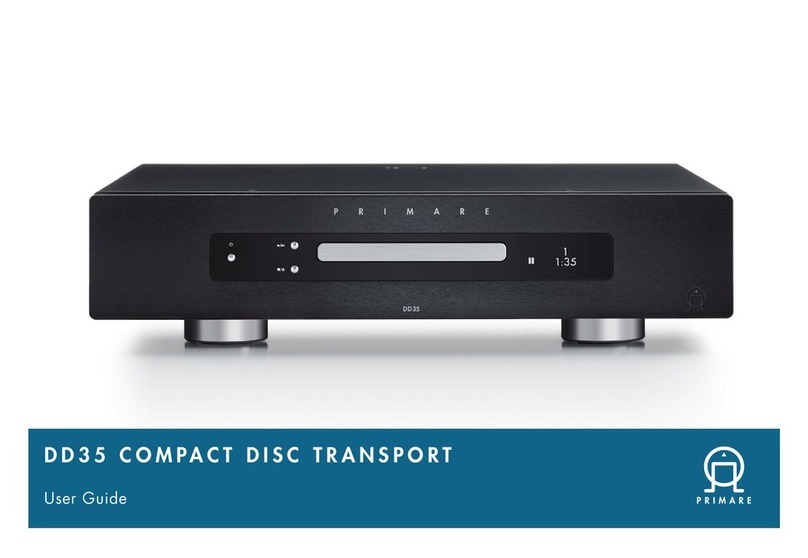
Primare
Primare DD35 User manual
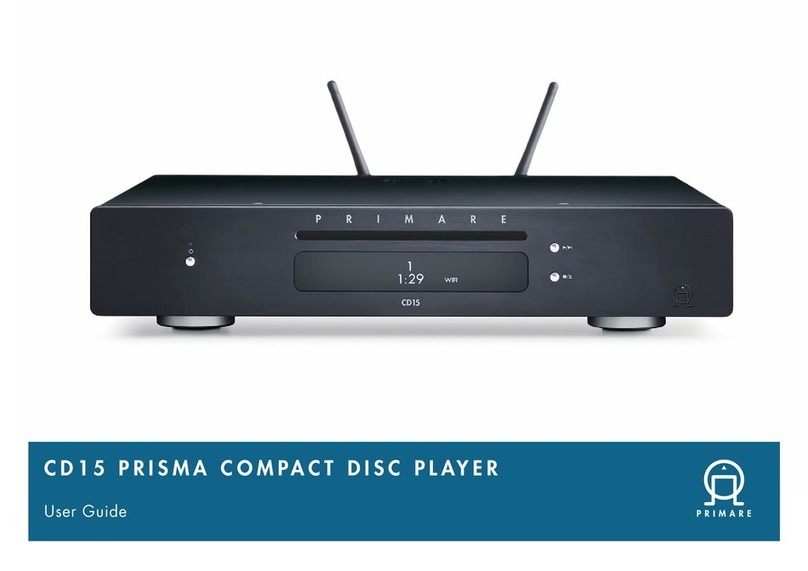
Primare
Primare CD15 PRISMA User manual
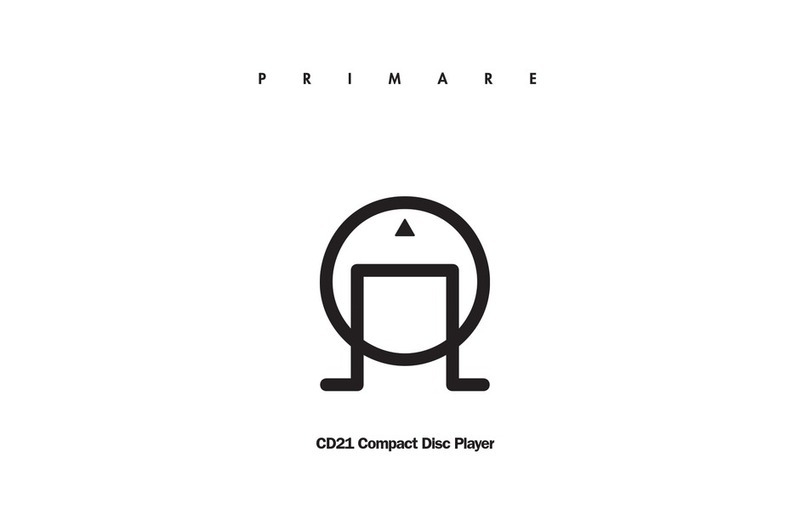
Primare
Primare CD21 User manual

Primare
Primare CD35 User manual

Primare
Primare CD35 User manual
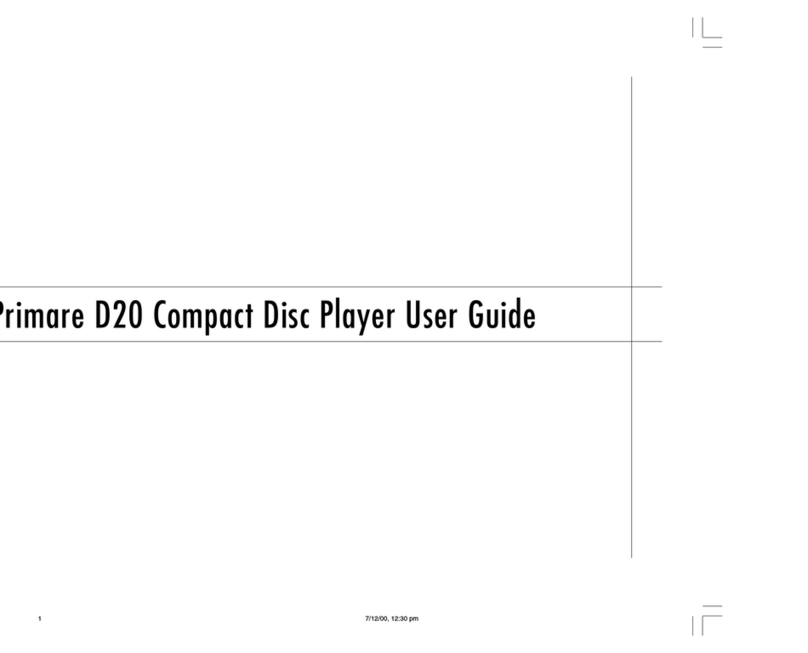
Primare
Primare D20 User manual

Primare
Primare CDI10 User manual

Primare
Primare CD21 User manual

Primare
Primare CD31 User manual
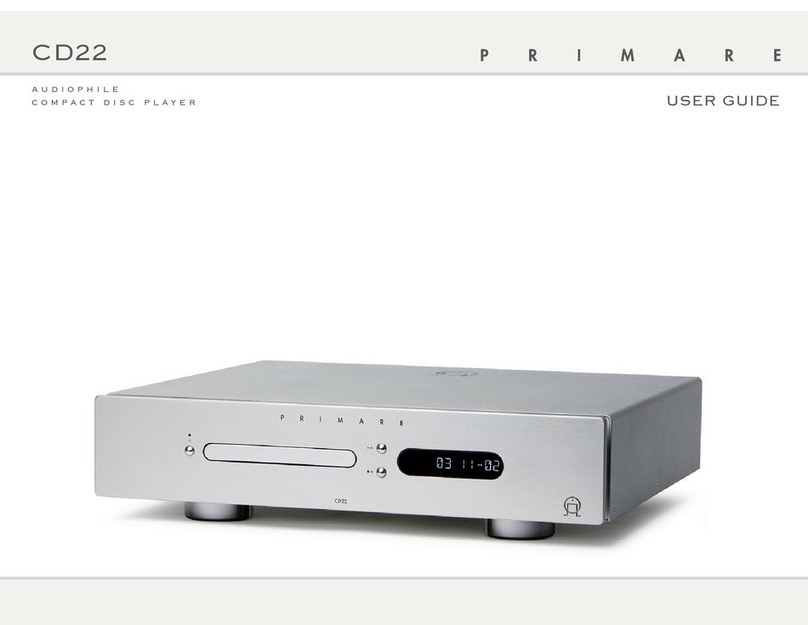
Primare
Primare CD22 User manual
